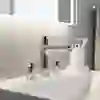How to Remove Limescale from Different Surfaces
The best method depends on the surface you are cleaning. Always test a small, inconspicuous area first, especially on delicate finishes like natural stone, marble, black matt taps, gold, or brushed brass, which can be damaged by acids.
Removing Limescale From Tiles / Removing Limescale From Sinks
Spray Method: Mix one part white vinegar or lemon juice with four parts water in a spray bottle. Spritz the solution onto the tiles or sink and let it sit for up to an hour for stubborn deposits. Then, scrub with a sponge or brush and rinse thoroughly.
Paste Method: For a more targeted approach, create a paste with baking soda and water (about three parts baking soda to one part water). Apply the paste to the affected areas, let it dry, and then scrub with a sponge or brush.
Steam Cleaning: A steam cleaner can also be used to loosen and remove limescale from tiles and other hard surfaces.
Removing Limescale From Taps
Soaking Method: This is the most effective way to deal with limescale on taps, as it allows the acid to stay in contact with the deposit.
- Soak a cloth or paper towel in white vinegar or lemon juice.
- Wrap the soaked cloth around the tap, securing it with an elastic band if needed.
- Leave it to work for a couple of hours or overnight for tough limescale.
- Remove the cloth, scrub away any remaining residue with an old toothbrush, and rinse thoroughly with water.
Lemon Halves: For the spout of a tap, you can cut a lemon in half and push it onto the spout so that the cut side is in contact with the limescale. Leave it for an hour, then rinse and wipe clean.
Using Commercial Limescale Removers
If natural remedies don't do the trick, or for heavy build-up, you can use a commercial limescale remover. These products often contain stronger acids and are formulated for specific surfaces.
Check the ingredients: Many Eco-friendly cleaners use lactic acid, while stronger cleaners may contain phosphoric acid, sulfuric acid, or even hydrochloride acid. Be sure to use these in a well-ventilated area and with protective gear.
Follow the instructions: Always follow the manufacturer's instructions for application time and rinsing.




